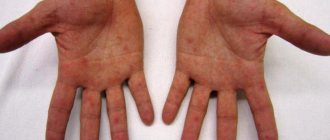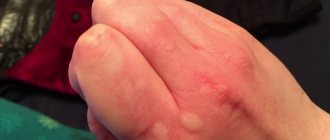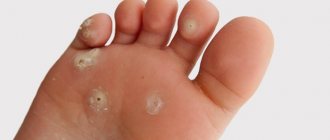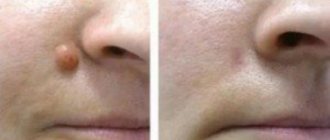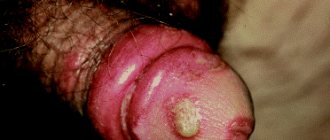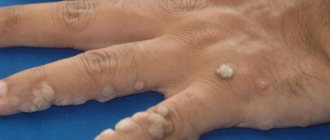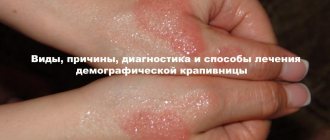Causes
If alarming symptoms appear, it is worth finding out the cause of hives on the legs. The disease can be triggered by both external and internal factors. The effectiveness of treatment depends on successful diagnosis.
Causes of hives on legs:
- allergen exposure – medications, food, sun, wind, insect bites, pollen, animal hair, dust, water, household chemicals;
- hereditary predisposition - if there are allergies in the family.
It is worth noting that hives on the legs can be triggered by any allergens - inhaled with air, in contact with the skin, and also entering the body through the gastrointestinal tract. The ways in which the irritant enters are varied.
Factors that provoke urticaria on the legs:
- changes in air temperature;
- overheating or hypothermia;
- exposure to sunlight;
- mechanical damage to the legs, scratches, cuts to the feet;
- thermal effects - burns, frostbite;
- prolonged compression of the legs or feet;
- synthetic clothing;
- breakdown;
- weakened immune system;
- diseases of internal organs;
- fungal infections;
- helminthic infestations.
All of the above factors increase the likelihood of hives on the legs in a person prone to allergic reactions.
Sample patient menu
1 option
Breakfast – buckwheat with water, yogurt without sugar.
Lunch – green vegetable soup, boiled rabbit or chicken meat, pasta, dried apple compote.
Dinner – baked potatoes.
Option 2
Breakfast - oatmeal with water with the addition of a green apple, dry biscuits without sugar, tea.
Lunch – boiled vegetables, vegetable soup, steamed lean meat cutlets, green tea. Dinner – pasta sprinkled with hard cheese.
There is no need to panic or despair if unexpected symptoms of urticaria appear. The main thing is timely consultation with doctors, accurate diagnosis, and dietary nutrition.
Symptoms
Hives rashes can appear on any part of the body. Foci of inflammation are localized on several parts at once - arms, legs, torso, face. But it is possible that urticaria may appear in only one place, most often on the lower extremities; even the feet and fingers may be involved.
An allergic disease can be recognized by its characteristic rash. It resembles nettle burns, hence the name “urticaria.” Blisters on the feet appear unexpectedly, appearing right before our eyes. They have a pinkish or red-pink tint, can rise above the surface of the skin or be level with the skin, flat. As the inflammatory process with urticaria increases, blisters on the legs acquire a grayish or whitish tint, and purulent-inflammatory processes are observed.
The spots, as a rule, have an irregular, closer to oval, shape. After a short time, they suddenly disappear, just as they appeared. After them, there are no traces, no scars, no scars left on the legs.
However, you should not make a diagnosis yourself; consultation with a specialist is necessary; it is important to determine the form of the disease and calculate the allergen.
In addition to the rash, when urticaria occurs, the patient exhibits the following symptoms:
- severe itching, which worsens in the evening and at night;
- dryness and flaking of the skin of the feet;
- swelling of inflamed areas;
- merging of blisters together, the formation of extensive spots;
- weakness, lethargy;
- loss of appetite;
- chills, increased body temperature (with severe damage to the skin);
- headache, less often – migraine.
These symptoms of hives should be a reason to go to the hospital.
Urticaria on the legs in adults: symptoms, causes, treatment and prevention
Dermatitis in its various manifestations has recently become more common. This is primarily influenced by environmental factors and the quality of food consumed by people. Urticaria on the legs does not go unnoticed either.
This is one of the common diseases encountered in medical practice. It is important to promptly determine the presence of pathology and understand how serious it can be in order to seek help from specialists.
This will prevent it from becoming chronic and developing all sorts of consequences.
Description of the disease
Urticaria on the legs is one of the types of allergic pathologies that manifests itself on human skin. It rarely appears as an independent disease. In most cases, it is a consequence of other, more dangerous health problems.
Pathology can manifest itself at any age, regardless of gender. However, it is most often diagnosed in children over three years of age and in the fair sex.
Therapeutic measures
Treatment of urticaria on the legs must be correct and comprehensive. To achieve a positive result, it is first necessary to eliminate the cause - the irritant.
Local therapy is recommended as soon as the first rash appears. To do this, use the following means:
- 1% menthol solution containing alcohol. It does not have a healing effect, but it relieves itching well.
- Gel Fenistil. It is a local antihistamine. Eliminates swelling, prevents the development of the inflammatory process, relieves itching.
- Corticosteroids – Hydrocortisone ointment, Mometasone. Relieves inflammation and allergies.
The appearance of hives on the legs can be quite life-threatening for the patient. Against the background of contact with an allergen and if a hyperreaction occurs, it is possible that Quincke's edema or anaphylactic shock may occur.
The need for systemic treatment arises even with a mild form of the pathology. Duration and dosage are determined based on the severity and volume of the rash.
The main medications that can be used in the treatment of urticaria on the legs:
- Antihistamines (Erius, Suprastin, Diphenhydramine, Cetrin). Helps suppress the production of histamine, which stops the reaction to allergens. Prescribed for any form of pathology. Some of them have a sedative and hypnotic effect, so driving is contraindicated while taking it.
- Sorbents (Smecta, Activated Carbon, Enterosgel). They are mainly used for allergies caused by eating foods. Helps quickly remove allergens from the body.
- Corticosteroids (Hydrocortisone, Prednisolone). Designed to quickly and effectively eliminate an allergic reaction. If there is a threat of anaphylactic shock or angioedema, Dexamethasone is administered intravenously.
- Sedatives (Corvalol, Adaptol, Glycine). These medications are prescribed by a neurologist. Indications for use are rashes caused by stress or nervous experiences.
Since in most cases the development of diseases on the legs is promoted by a food allergen, it is necessary to adhere to a special diet. This will prevent future relapses.
The diet should be balanced and include the following foods:
- vegetable oil;
- green tea;
- durum wheat pasta
- fructose as a sugar substitute;
- chicken, rabbit, turkey meat
- green fruits and vegetables;
- whole wheat bread;
- low-fat fermented milk products.
It is necessary to exclude from the diet:
- citrus;
- bright red berries and fruits;
- coffee and drinks containing caffeine;
- chocolate and flour;
- nuts;
- conservation;
- smoked meats;
- eggs and milk;
- alcoholic drinks.
When a specific allergen is identified, it must also be excluded from consumption.
You need to follow a diet during treatment for urticaria for at least six weeks, even in the absence of major symptoms.
Prohibited foods should be introduced into the diet gradually. In this case, there should be careful monitoring of the body’s reaction.
When carrying out all therapeutic measures aimed at eliminating the disease, it is important to drink about 2 liters of liquid per day.
Types and stages
Based on the nature of the course, the following stages of urticaria on the legs can be distinguished:
- Spicy . Rashes on the legs occur within a short period of time after the action of the irritant. The appearance of bright pink spots is accompanied by severe itching and swelling of the skin.
- Chronic. This form of urticaria is characteristic of regular exposure (more than 6 months) to the irritant in small doses. Symptoms of allergies on the legs appear from time to time, the symptoms appear and disappear, and do not cause severe discomfort to the patient. The blisters are pale pink in color and small in size. During an exacerbation, the legs swell, a headache appears, and the body temperature rises.
- Persistent papular. This form is characterized by the formation of papules on the feet. This is a type of chronic urticaria. Papules on the legs do not go away for a long time, cause pain, and cause discomfort while walking.
- Quincke's edema. This is the most severe form of urticaria, which often manifests itself against the background of skin rashes. It is accompanied by swelling of the laryngeal mucosa, which can lead to suffocation.
Depending on the irritant, urticaria on the legs in adults and children can be of the following types:
- solar – skin rashes on the legs appear immediately after exposure to ultraviolet rays;
- cold – caused by hypothermia;
- thermal – spots on the legs appear after overheating, for example, after taking a hot bath or visiting a sauna;
- aquagenic – urticaria appears after contact with water;
- dermographic – occurs as a result of physical impact, blisters on the feet form in a place of increased pressure or friction, for example, when wearing tight shoes;
- food - allergenic foods act as irritants.
Sample patient menu
1 option
Breakfast – buckwheat with water, yogurt without sugar.
Lunch – green vegetable soup, boiled rabbit or chicken meat, pasta, dried apple compote.
Dinner – baked potatoes.
Option 2
Breakfast - oatmeal with water with the addition of a green apple, dry biscuits without sugar, tea.
Lunch – boiled vegetables, vegetable soup, steamed lean meat cutlets, green tea. Dinner – pasta sprinkled with hard cheese.
There is no need to panic or despair if unexpected symptoms of urticaria appear. The main thing is timely consultation with doctors, accurate diagnosis, and dietary nutrition.
Diagnostics
Urticaria on the legs is difficult to confuse with any other disease. The doctor will be able to make the correct diagnosis after a visual examination of the patient’s body.
Due to the variety of forms of urticaria, doctors may resort to additional examination techniques to confirm their assumptions.
Additional diagnostic methods:
- blood analysis;
- biochemistry;
- blood for immunoglobulin;
- skin allergy tests (skin contact with a probable allergen);
- swab from the throat and nose;
- feces on worm eggs;
- analysis of stool for dysbacteriosis;
- blood for thyroid hormones;
- Ultrasound of organs.
A comprehensive examination is carried out if doctors do not see a relationship between the appearance of hives on the legs and exposure to any irritant.
Sample patient menu
1 option
Breakfast – buckwheat with water, yogurt without sugar.
Lunch – green vegetable soup, boiled rabbit or chicken meat, pasta, dried apple compote.
Dinner – baked potatoes.
Option 2
Breakfast - oatmeal with water with the addition of a green apple, dry biscuits without sugar, tea.
Lunch – boiled vegetables, vegetable soup, steamed lean meat cutlets, green tea. Dinner – pasta sprinkled with hard cheese.
There is no need to panic or despair if unexpected symptoms of urticaria appear. The main thing is timely consultation with doctors, accurate diagnosis, and dietary nutrition.
Treatment
The main rule in the treatment of urticaria on the legs is not to self-medicate. Do not use untested topical medications or apply a cold compress to relieve itching. The reaction may be unexpected; instead of relief, angioedema may develop.
First aid for hives on the legs is to use an antihistamine internally and externally. It is also important to break the relationship with the allergen.
Therapy for urticaria is selected depending on the form of the disease, since it is important to exclude the irritant.
Medicines for urticaria on the legs
Drug therapy for urticaria on the legs looks like this:
- antihistamines - orally: Suprastin, Edem, Zirtek, Zodak, externally: Diphenhydramine solution, Fenistil gel or Psilo-balm;
- sorbents – Smecta;
- non-hormonal ointments – Bepanten, D-panthenol, Skin-cap;
- glucocorticosteroids (in severe cases) - Dexamethasone, Prednisolone (injections), locally: Advantan, Lorinden S, Sinaflan, Elokom, Hydrocortisone;
- probiotics – Lactiale, Linex.
Acute urticaria on the legs is more treatable than the chronic form. In severe cases, immunosuppressants are prescribed. For this disease, Omalizumab or Cyclosporine can be used.
Traditional methods for urticaria on the legs
Photo from the site gourman-bel.ru
You need to be careful with traditional medicine. It is necessary to know exactly the body’s reaction to medicinal herbs and to exclude individual intolerance.
Internally to cleanse the body for this allergic disease, you can take:
- Castor oil;
- nettle decoction;
- infusion of celandine.
To reduce the inflammatory process in urticaria, a decoction of chamomile, calendula, celandine, and menthol solution should be used externally. Lotions are applied to the legs for 10–15 minutes.
Diet for urticaria on the legs
Dietary nutrition not only helps to alleviate the condition during an exacerbation of urticaria, but also prevents relapse. The most important diet for food allergies, it looks like this:
- remove from the diet all possible allergenic products - those containing dyes, preservatives and other harmful additives, chocolate and sweets, citrus fruits, dairy products (if you are allergic to cow's milk protein);
- give up sugar, hot spices and seasonings, marinades and pickles;
- do not drink alcohol, carbonated drinks, store-bought juices;
- give up fatty and fried foods, animal by-products, sausages, smoked meats;
- instead of butter, it is better to give preference to vegetable oil;
- consume pasta only from durum varieties;
- remove eggs and seafood (mussels, shrimp, red caviar) from the diet.
If you have hives, you need to eat food prepared at home, no fast food or restaurant food. It is necessary to drink at least 2 liters of water per day to expel allergens from the body.
After recovery and disappearance of all symptoms of urticaria, the diet should be followed for at least 2 weeks.
Urticaria on the legs: 8 photos with descriptions, causes, symptoms, treatment
Urticaria on the legs is an allergic-type disease that manifests itself in the form of a red rash and intense itching. Caused by improper functioning of the immune system.
Causes of hives on legs
There are many causes for hives on the legs. However, in most cases, the improper functioning of the immune system is to blame, namely, the body’s hypersensitivity and its excessive reaction to any irritant.
In general, there are two categories of irritants:
- Internal. Medicines and foods, severe or prolonged stress.
- External. Reaction to temperature changes, solar radiation, insect bites, friction, detergents, dust, animal hair and fluff, pollen, perfume, aerosol liquids.
The most common medications that cause a reaction are antibiotics, anti-inflammatory drugs, and some painkillers.
The most common mechanical causes are:
- squeezing or rubbing the feet with clothes and shoes (the reaction occurs due to problems with blood circulation);
- increased sweating of the feet (a common cause of urticaria on the feet, since salt, which is involved in skin reactions, comes to the surface along with sweat);
- scratches and wounds.
A predisposition to urticaria occurs in people with the following diseases:
- problems with the gastrointestinal tract;
- endocrine pathologies;
- bacterial and viral infections (especially herpes and hepatitis B, C);
- liver and kidney pathologies;
- arthritis;
- vegetative disorders;
- presence of tumors;
- infection with parasites such as helminths and Giardia (rashes on the legs are often caused by roundworms).
Diseases provoke a slowdown in histamine destruction. It is excess histamine that leads to an allergic reaction.
Often, to determine the real cause of the rash on the legs, you have to undergo a lengthy examination.
Find out more
Symptoms of urticaria on the legs
The name of the pathology is due to the similarity of the reaction with a rash from a nettle burn.
The key symptoms by which the disease can be identified are as follows:
- areas of redness (this is clearly visible in the photo of hives on the legs);
- rashes in the form of small or medium-sized pinkish-red spots (sometimes they can merge into large formations);
- papules and blisters (rounded formations slightly rising above the surface with clearly defined boundaries, in rare cases they can turn into vesicles);
- intense itching (observed in all cases);
- temperature rise.
The rashes appear unevenly. In addition, the formations can vary greatly in size: in one zone they are small, in another they are larger (10 cm in diameter). In most cases, the rash occurs on both legs.
For some, symptoms may be more severe and painful. In this case, the patient experiences:
- muscle pain;
- chills;
- swelling;
- difficulty breathing;
- arrhythmia;
- migraine and dizziness.
The rash goes away within a few hours or days. In the chronic form, it can occur in paroxysms over several months. The rash goes away abruptly and unexpectedly, leaving no traces behind. The skin takes on its usual appearance.
Types of urticaria on the legs
There are three forms of pathology:
- Spicy. The duration of symptoms is from 2 hours to 10-15 days. It usually has the nature of an allergic reaction and develops in response to foods, medications, bee and ant stings, as well as infections.
- Chronic. Lasts for 1-5 months. It is provoked by internal disorders. Such as chronic infection, progressive tumor, malfunction of certain organs, difficult pregnancy.
- Recurrent. Or episodic. In this case, attacks are repeated many times over a certain period of time.
In the case of a rash on the legs, acute urticaria of the mechanical type most often occurs.
Varieties by location:
- Feet. The rash is symmetrical and affects both legs. Photos of hives on the feet can be easily found on the Internet.
- Legs. Light pink spots, sometimes merging into one large formation. Only one leg may be affected. It is most often localized on the lower legs, less often on the thighs.
- Fingers. The formations are very painful and itchy, causing discomfort when walking. Cracks may form on the skin. Most often it appears due to wearing tight, uncomfortable shoes.
The exact type of disease is determined in the hospital.
Treatment of urticaria on the legs
Any therapy begins with identifying and eliminating the provoking factor. This is easiest to do when the pathology is acute. In cases of the chronic form, the patient needs to undergo a long examination and tests.
Urticaria on the legs of a child is treated with the following methods:
- complete elimination of the provoking factor;
- taking antihistamines (emergency treatment measure);
- a diet compiled individually and prescribed by a doctor;
- a course of enterosorbents (drugs help remove the irritant from the child’s body);
- external skin soothing agents, including ointments and cold compresses.
Urticaria on the legs in adults, regardless of the reasons for its appearance, is resolved in a similar way. However, in their case, more potent drugs can be used.
In both cases, an important part of therapy is the diet, which includes mainly dairy and plant foods.
Drug treatment for urticaria on the legs
Medication therapy includes the following:
- Antihistamines. They are in the form of tablets. Accepted on a first come first serve basis. The doctor may prescribe a whole course. The standard course duration is from 2-4 weeks to 5 months, depending on the severity of the case and the age of the patient.
- Sedatives. Designed to reduce the patient's discomfort, relieve itching, swelling and pain.
- Soothing ointments, creams, gels. Needed to soothe the skin and relieve itching. Can be used as prophylaxis.
- Corticosteroids. Hormonal drugs. Refers to measures of severe potent therapy. Prescribed only to adults in serious cases. Course duration is no more than 7 days.
- Diuretics. Laxatives are rarely prescribed and are used exclusively as an additional measure.
Most drugs begin to act within 5-10 minutes after use.
Treatment with folk remedies for urticaria on the legs
Folk remedies are an optional and auxiliary measure. Before using any of the products, consultation with a doctor is required.
Some folk recipes:
- Castor oil. It is used as a laxative to remove allergens from the body. Can be mixed with celandine.
- Nettle lotions. The leaves (can be taken along with the stems) are brewed with boiling water and left to cool completely. Strain. The resulting solution is used to wash the affected area 3-5 times a day. You can soak gauze in it and apply it to the skin for 5-10 minutes.
- Valerian-linden decoction. Linden, valerian and lemon balm are mixed in identical proportions. Grind. One tablespoon is poured with water and boiled for 2-4 minutes. The decoction is drunk 50-70 ml per day.
- Intoxicating decoction. Valerian root, as well as the root parts of lemon balm and hops, are mixed in equal proportions and crushed. One tablespoon of herbs is poured with water, put on gas, wait until it boils and hold for another 2 minutes. Take off the fire. Drink 50 ml three times a day.
- Yasmen infusion. Linden flowers, woodruff grass and walnut leaves are taken in equal proportions. Pour boiling water over everything and leave until completely cooled. Drink before meals.
Traditional methods are best combined with drug therapy or used as prophylaxis - outside of periods of rashes. Separately, they will not bring the desired effect.
Preventive measures
Only a doctor who has become familiar with the specific symptoms can tell how to treat hives on the legs. However, in any case, it is worth taking preventive measures. They will help alleviate the condition during illness, as well as prevent relapses.
The list of necessary measures is as follows:
- Treat infectious and viral diseases, as well as pathologies of the stomach and liver in a timely manner. Prevent diseases from becoming chronic.
- Avoid contact with the provoking factor. This will prevent outbreaks of pathology.
- Watch your diet. The diet should be healthy, varied and free of potential allergens. In addition, it is advisable to give up sweets, alcoholic drinks and fried foods.
- Always carry antihistamines with you. Hives can appear unexpectedly.
- Regularly use moisturizing and soothing creams. You can apply short cold compresses.
- Wear comfortable clothes. It should be spacious and made of natural fabrics.
- Avoid uncomfortable shoes. Shoes must be exactly the right size and preferably not made of synthetic materials.
- Get rid of bad addictions. For example, from smoking and alcohol.
- Strengthen immunity. By adjusting nutrition, taking vitamins and hardening procedures.
- Take courses of therapy aimed at reducing the body's sensitivity to the allergen.
It should also be remembered that in the autumn and spring periods, chronic pathologies worsen and immunity decreases.
If you approach therapy and prevention correctly, urticaria will not bother you.
Complications
The consequence of the untreated acute form is the chronic course of urticaria. When the process becomes chronic, the risk of severe consequences increases.
The most terrible complication of urticaria, regardless of location, is Quincke's edema. It can be recognized by the following symptoms:
- severe swelling of the eyelids, lips, tongue, larynx;
- worsening breathing, shortness of breath;
- hoarseness of voice;
- the appearance of wheezing;
- increased heart rate;
- barking cough.
When an attack of suffocation begins, a spasmodic dry cough appears, the face turns red, and the nasolabial triangle turns white, and vomiting may begin. The person needs emergency medical care, otherwise he will die from lack of air.
Before the ambulance arrives, an attack of suffocation can be alleviated as follows:
- provide access to fresh air;
- reassure the patient, since stress only aggravates the attack;
- unfasten clothing that is constricting the neck area;
- give an antihistamine (preferably in syrup form, as swallowing the tablet may be difficult);
- if you have a compressor inhaler, then breathe in a glucocorticosteroid drug, for example, Dexamethasone.
These actions should alleviate the patient’s condition until doctors arrive. Further treatment of urticaria and its complications is carried out in the hospital.
Prevention
Prevention of hives is important. Preventive actions:
- hypoallergenic diet;
- avoiding contact with a possible allergen;
- taking antihistamines for seasonal allergies in the spring;
- healthy lifestyle;
- avoiding stress;
- choosing clothes only from natural fabrics;
- use of hypoallergenic cosmetics for foot care;
- maintaining optimal climatic conditions in the house - air temperature no higher than 24 ˚C;
- regular wet cleaning.
Urticaria on the toes often occurs due to improperly sized or poor-quality shoes, excessive sweating and fungal diseases. That is why you should give preference to comfortable leather shoes and socks made from natural materials. It is necessary to cure fungal infections and maintain foot hygiene.
Treatment for hives should begin as soon as the blisters appear. There is no point in waiting for the disease to go away on its own. It is necessary to find out the cause of the allergy on the legs and eliminate it once and for all, so that a chronic form does not occur.
Author: Oksana Belokur, doctor, especially for Dermatologiya.pro
Useful video about urticaria
List of sources:
- Kolhir P.V. Urticaria and angioedema. – M.: Practical Medicine, 2012. – 363 p.
- Latysheva T.V. Causes of emergency allergic situations and some aspects of their treatment and prevention // Attending physician. – 2000. – No. 4. - With. 48–49.
- Luss L.V. Modern ideas about the pathogenesis and principles of treatment of urticaria and angioneurological angioedema // Attending physician. – 2001. – No. 4. - With. 26–30.
We recommend reading:
- Furuncle under the armpit: symptoms and treatment methods
- Streptoderma on the face: symptoms, types, treatment

